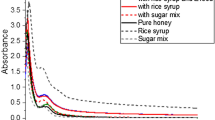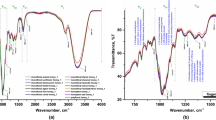Abstract
This research seeks to construct a Machine Learning (ML)-based method for identifying adulterated honey utilizing honey mineral element profiles. The proposed system comprises two phases: preprocessing and classification. The preprocessing phase involves the treatment of missing-value attributes and normalization. In the classification phase, we use three supervised ML models: logistic regression, decision tree, and random forest, to discriminate between authentic and adulterated honey. To evaluate the performance of the ML models, we use a public dataset comprising measurements of mineral element content of authentic honey, sugar syrups, and adulterated honey. Experimental findings show that mineral element content in honey provides robust discriminative information for detecting honey adulteration. Results also demonstrate that the random forest-based classifier outperforms other classifiers on this dataset, achieving the highest cross-validation accuracy of 98.37%.
Access this chapter
Tax calculation will be finalised at checkout
Purchases are for personal use only
Similar content being viewed by others
References
Al-Awadhi MA, Deshmukh RR (2021) A review on modern analytical methods for detecting and quantifying adulteration in honey. In: 2021 international conference of modern trends in information and communication technology industry (MTICTI), pp 1–6. IEEE. https://doi.org/10.1109/mticti53925.2021.9664767
Tosun M (2013) Detection of adulteration in honey samples added various sugar syrups with 13C/12C isotope ratio analysis method. Food Chem 138:1629–1632. https://doi.org/10.1016/j.foodchem.2012.11.068
Islam MK, Sostaric T, Lim LY, Hammer K, Locher C (2020) Sugar profiling of honeys for authentication and detection of adulterants using high-performance thin layer chromatography. Molecules (Basel, Switzerland) 25. https://doi.org/10.3390/molecules25225289
Al-Mahasneh M, Al-U’Datt M, Rababah T, Al-Widyan M, Abu Kaeed A, Al-Mahasneh AJ, Abu-Khalaf N (2021) Classification and prediction of bee honey indirect adulteration using physiochemical properties coupled with k-means clustering and simulated annealing-artificial neural networks (SA-ANNs). J Food Qual. https://doi.org/10.1155/2021/6634598
Song X, She S, Xin M, Chen L, Li Y, Heyden YV, Rogers KM, Chen L (2020) Detection of adulteration in Chinese monofloral honey using 1H nuclear magnetic resonance and chemometrics. J Food Compos Anal 86. https://doi.org/10.1016/j.jfca.2019.103390
Liu W, Zhang Y, Han D (2016) Feasibility study of determination of high-fructose syrup content of Acacia honey by terahertz technique. Infrared, Millimeter-Wave, Terahertz Technol IV. 10030, 100300J. https://doi.org/10.1117/12.2245966
Guelpa A, Marini F, du Plessis A, Slabbert R, Manley M (2017) Verification of authenticity and fraud detection in South African honey using NIR spectroscopy. Food Control 73:1388–1396. https://doi.org/10.1016/j.foodcont.2016.11.002
Azmi MFI, Jamaludin D, Abd Aziz S, Yusof YA, Mohd Mustafah A (2021) Adulterated stingless bee honey identification using VIS-NIR spectroscopy technique. Food Res 5:85–93. https://doi.org/10.26656/fr.2017.5(S1).035
Al-Awadhi MA, Deshmukh RR (2022) Honey adulteration detection using hyperspectral imaging and machine learning. In: 2022 2nd international conference on artificial intelligence and signal processing (AISP), pp 1–5. IEEE. https://doi.org/10.1109/AISP53593.2022.9760585
Bodor Z, Kovacs Z, Rashed MS, Kókai Z, Dalmadi I, Benedek C (2020) Sensory and physicochemical evaluation of acacia and linden honey adulterated with sugar syrup. Sensors (Switzerland). 20:1–20. https://doi.org/10.3390/s20174845
Irawati N, Isa NM, Mohamed AF, Rahman HA, Harun SW, Ahmad H (2017) Optical microfiber sensing of adulterated honey. IEEE Sens J 17:5510–5514. https://doi.org/10.1109/JSEN.2017.2725910
Luo L (2020) Data for: discrimination of honey and adulteration by elemental chemometrics profiling. Mendeley Data V1. https://doi.org/10.17632/tt6pp6pbpk.1
Liu T, Ming K, Wang W, Qiao N, Qiu S, Yi S, Huang X, Luo L (2021) Discrimination of honey and syrup-based adulteration by mineral element chemometrics profiling. Food Chem 343:128455. https://doi.org/10.1016/j.foodchem.2020.128455
Templ M, Templ B (2021) Statistical analysis of chemical element compositions in food science: problems and possibilities. Molecules 26:1–15. https://doi.org/10.3390/molecules26195752
Singh D, Singh B (2020) Investigating the impact of data normalization on classification performance. Appl Soft Comput 97:105524. https://doi.org/10.1016/j.asoc.2019.105524
Tsangaratos P, Ilia I (2016) Comparison of a logistic regression and Naïve Bayes classifier in landslide susceptibility assessments: the influence of models complexity and training dataset size. CATENA 145:164–179. https://doi.org/10.1016/j.catena.2016.06.004
Safavian SR, Landgrebe D (1991) A survey of decision tree classifier methodology. IEEE Trans Syst Man Cybern 21:660–674. https://doi.org/10.1109/21.97458
Breiman L (2001) Random forest. Mach Learn 45:5–32
Acknowledgements
This research was supported by the Department of Science and Technology’s Funds for Infrastructure through Science and Technology (DST-FIST) grant SR/FST/ETI-340/2013 to Dr. Babasaheb Ambedkar Marathwada University in Aurangabad, Maharashtra, India. The authors would like to express their gratitude to the department and university administrators for providing the research facilities and assistance.
Author information
Authors and Affiliations
Corresponding author
Editor information
Editors and Affiliations
Rights and permissions
Copyright information
© 2023 The Author(s), under exclusive license to Springer Nature Singapore Pte Ltd.
About this paper
Cite this paper
Al-Awadhi, M.A., Deshmukh, R.R. (2023). A Machine Learning Approach for Honey Adulteration Detection Using Mineral Element Profiles. In: Shukla, P.K., Singh, K.P., Tripathi, A.K., Engelbrecht, A. (eds) Computer Vision and Robotics. Algorithms for Intelligent Systems. Springer, Singapore. https://doi.org/10.1007/978-981-19-7892-0_29
Download citation
DOI: https://doi.org/10.1007/978-981-19-7892-0_29
Published:
Publisher Name: Springer, Singapore
Print ISBN: 978-981-19-7891-3
Online ISBN: 978-981-19-7892-0
eBook Packages: Intelligent Technologies and RoboticsIntelligent Technologies and Robotics (R0)




